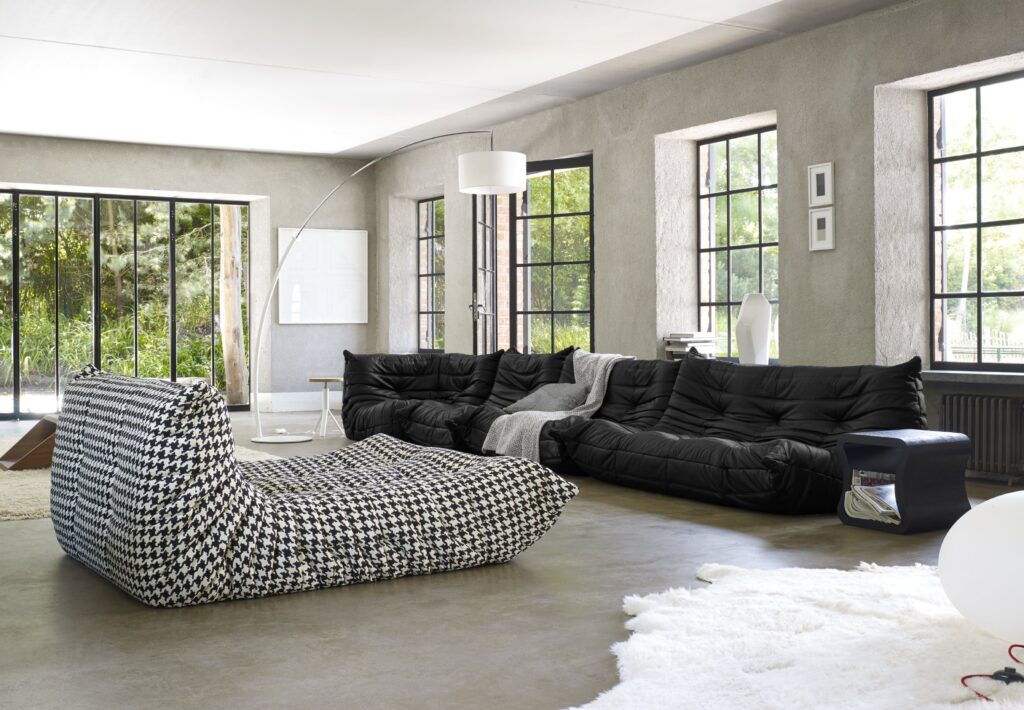Discover our e-shop and access a digital catalogue of over 40.000 design products.
Go to shop18 January 2022

Formal and design innovation make this sofa still current and surprising
In 1973 the Ligne Roset brand was born in France and in the same year the company put into production the Togo sofa, designed by Michel Ducaroy. Since then Togo has never stopped being produced by Ligne Roset and over the years it has increasingly become its symbol. The formal approach is typical of the 1970s: organic textures, generous seating, padding with innovative proportions. In particular, the Capitonné workmanship takes on a whole new geometry in Togo, characterized by long rectangular sections that not only determine its aesthetics, but also help to give support and comfort to the body. One of the first aspects that are noticed is the absence of base or feet, an attribute that made the first critics of his time turn up their noses, the same ones who awarded him the prestigious René-Gabriel prize in 1973. In terms of absences, in the classic three-seater model, we note the lack of armrests, another common trait in those years and a recurring theme also in other sofas designed by Ducaroy himself.

Reviewed and analyzed over the decades, Togo has been defined as a “brutalist sofa”, “wrinkled” and “social icon” but the words of its designer really describe its real philosophy. “A tube of toothpaste folded on itself like a tuba and fixed at both ends”: with these words Ducaroy described the inspiration for the Togo project, with a mixture of under-statement and pop taste that characterizes the project itself . Far from the classic stereotype of the bourgeois sofa, Togo, not surprisingly, was conceived in the immediate post-68 period when the urge for creative freedom, combined with new tools and more versatile materials, broadened the formal perspectives and design possibilities. Suffice it to say that for the realization of Togo three different types of polyurethane foam are used, each with a specific density, which are assembled to create the structure.

Lightness is another key word that identifies Togo. In practice, the three-seater model without armrests weighs, for example, 15kg. This makes it extremely versatile and easily movable. An interesting feature at a time when the house requires a layout that is as fluid and reconfigurable as possible. After all, Togo is a chameleonic sofa. From the gritty leather upholstery to the more glamorous velvet, up to the fabric in countless colors, this sofa can change its face and adapt to all the style updates of the environment in which it is located.

The collection consists of various models. In addition to the aforementioned three-seater without armrests, Togo is also present, for example, as a pouf, armchair, corner armchair. All elements designed to exist independently or in modular configurations, possible to combine indefinitely. Also interesting is the possibility of combining different coatings and colors to create tone-on-tone or contrasting combinations.

Togo was born and continues to be a sofa to be lived in, in which to relax. It invites you to relax and accompanies moments of informal conviviality. It has no sharp edges or hard areas, it is a total tribute to softness. Yet the uniqueness of its design makes it suitable for any decorative context. Not only contemporary but also hyper-classic, in a measured game of formal contrasts.

Aesthetics and design, style and intelligence have led Togo to the milestone of half a century of success. Alongside the chromatic evolutions that this sofa has experienced, evolutions that have supported the change in taste and needs, leading Togo to transform itself: from a subversive design model to a timeless icon.